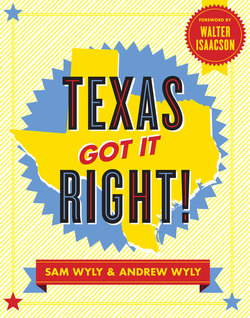Читать книгу Texas Got It Right! - Sam Wyly - Страница 27
На сайте Литреса книга снята с продажи.
Оглавлениеwith many Americans of Scots-Irish decent, Hous-
ton’s family history can be traced to Ulster, Ireland,
then across the Atlantic to Pennsylvania, to the
farms of the Shenandoah Valley, to Virginia, and
later to the mountains of East Tennessee. His Pres-
byterian upbringing engendered in him a respect
for the common man and for democratic ideals, and
his early life acquainted him intimately with the
value of hard physical work.
Abandoning a job at his family’s store in
Maryville, Tennessee, Houston left home at sixteen
to live with the Cherokee Indians on an island in
the Hiawassee River. To the Cherokees he was
known as the Raven. He adopted their language,
customs, and dress. Throughout his life, and espe-
cially in times of personal pain and uncertainty,
Houston turned to his adopted family for support
and guidance. His support for Indian nations put
him in conflict with his mentor, Andrew Jackson,
but Houston always held firm. “I am aware that in
presenting myself as the advocate of the Indians and
their rights,” he proclaimed to Congress, “I shall
stand very much alone.” But standing alone was not
something Houston feared.
That’s probably a big part of what drew him to
Texas in 1832. There was the lure of free land, sure,
but there was also the promise of building a future
unobstructed by conventional viewpoints and hierar-
chical political systems. Like so many others, Houston
was immediately caught up in the enthusiasm of the
Texas Revolution. Never hesitant to use strong words
or to take up arms for a cause, Houston became com-
mander-in-chief of the Army of Texas. In that capacity
he issued his eloquent and effective Call to Arms
against the Republic of Mexico in December 1835.
Years later, as a senator, Houston foresaw the cat-
aclysm that would become the Civil War. He urged
his fellow legislators to support the Compromise of
1850. In a stirring speech he invoked the scripture
with the words “a nation divided against itself cannot
stand.” It wasn’t until eight years later, as the nation
hurtled toward the disaster Houston had tried to
avert, that Abraham Lincoln made those words
famous for posterity. In short, Houston was a man of
arms who deemed keeping the peace the noblest deed
of the mighty.
Opposite: Sam Houston circa 1861. This page, left: This flag was
flown at a fort near Goliad before being destroyed during the
massacre there. (Houston had initially ordered his troops to
retreat, but he was not heeded until too late.) Right: The 576-foot-
tall San Jacinto Monument is the world’s tallest column, taller than
the Washington Monument. Its 220-ton star commemorates the
site of the Battle of San Jacinto.
TEXAS GOT IT RIGHT!
27
